Direct 2D与Direct 3D 11协同工作时遇到的一些问题
如何解决3D打印过程中的常见故障和问题
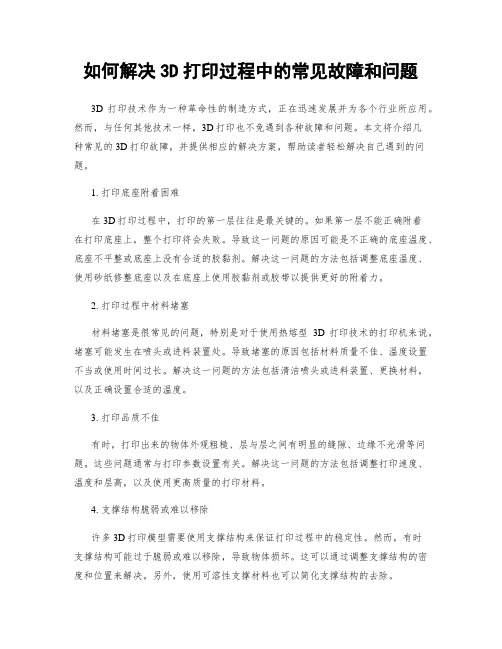
如何解决3D打印过程中的常见故障和问题3D打印技术作为一种革命性的制造方式,正在迅速发展并为各个行业所应用。
然而,与任何其他技术一样,3D打印也不免遇到各种故障和问题。
本文将介绍几种常见的3D打印故障,并提供相应的解决方案,帮助读者轻松解决自己遇到的问题。
1. 打印底座附着困难在3D打印过程中,打印的第一层往往是最关键的。
如果第一层不能正确附着在打印底座上,整个打印将会失败。
导致这一问题的原因可能是不正确的底座温度、底座不平整或底座上没有合适的胶黏剂。
解决这一问题的方法包括调整底座温度、使用砂纸修整底座以及在底座上使用胶黏剂或胶带以提供更好的附着力。
2. 打印过程中材料堵塞材料堵塞是很常见的问题,特别是对于使用热熔型3D打印技术的打印机来说。
堵塞可能发生在喷头或进料装置处。
导致堵塞的原因包括材料质量不佳、温度设置不当或使用时间过长。
解决这一问题的方法包括清洁喷头或进料装置、更换材料,以及正确设置合适的温度。
3. 打印品质不佳有时,打印出来的物体外观粗糙、层与层之间有明显的缝隙、边缘不光滑等问题。
这些问题通常与打印参数设置有关。
解决这一问题的方法包括调整打印速度、温度和层高,以及使用更高质量的打印材料。
4. 支撑结构脆弱或难以移除许多3D打印模型需要使用支撑结构来保证打印过程中的稳定性。
然而,有时支撑结构可能过于脆弱或难以移除,导致物体损坏。
这可以通过调整支撑结构的密度和位置来解决。
另外,使用可溶性支撑材料也可以简化支撑结构的去除。
5. 打印过程中出现倾斜或偏移如果打印件在打印过程中出现倾斜或偏移,可能是由于打印平台不平整、驱动系统故障或打印件没有正确固定。
解决这一问题的方法包括调整打印平台水平度、检查和维护驱动系统,以及使用夹具固定打印件。
6. 打印件粘性过高有时打印件粘附在底座上过于紧密,导致难以将其取下。
这可能是由于底座温度过高或打印材料粘性过高所致。
解决这一问题的方法包括降低底座温度、使用适当的底座材料(如玻璃纤维底座)或涂层,以便更轻松地取下打印件。
VS2010DirectX11SDKWindowsSDK编程过程中的错误异常解决方案记录

VS2010DirectX11SDKWindowsSDK编程过程中的错误异常解决⽅案记录ID3DBlob 未声明的标记符 undefined signalID3DBlob 定义在 D3DCommon.h 中, 但是使⽤ vs2010 & DirectX11 联合开发时, D3DCommon.h 会有两份, 如我的环境是:C:\Program Files\Microsoft SDKs\Windows\v7.0A\Include\D3DCommon.hD:\Program Files\Microsoft DirectX SDK (June 2010)\Include\D3Dcommon.h这样, 即使在项⽬中有包含 d3dx11.h (包含 D3DCommon.h) 也不能正确进⾏编译, 需要将 DirectX11 sdk 包含⽬录在 Windonws sdk 的前⾯, 如:D3DCOMPILE_ENABLE_STRICTNESS 未声明标记符D3DX11CompileFromFile() 创建加载并编译 shader⽂件时需要⽤到的 shaderFlags , 定义在 D3DCompiler.h 中, 需要 includexnamath.h 报错: 在标识符“XMConvertToRadians”的前⾯如下报错:1>d:\program files\microsoft directx sdk (june 2010)\include\xnamath.h(159): error C2146: 语法错误: 缺少“;”(在标识符“XMConvertToRadians”的前⾯)1>d:\program files\microsoft directx sdk (june 2010)\include\xnamath.h(159): error C2433: “FLOAT”: 不允许在数据声明中使⽤“__forceinline”1>d:\program files\microsoft directx sdk (june 2010)\include\xnamath.h(159): error C4430: 缺少类型说明符 - 假定为 int。
directdraw setmode error

directdraw setmode errordirectdrawsetmodeerror是一个普遍存在的Windows系统调试错误。
它可能会在您尝试运行游戏或应用程序时出现,使您无法继续进行。
DirectDraw Setmode错误意味着您的常规操作系统驱动程序出现了问题。
在某些情况下,这可能是由于由于操作系统或计算机的可用资源的负载造成的资源不足造成的。
为了解决DirectDraw Setmode错误,首先您需要做的就是更新您的DirectX驱动程序。
您可以从Microsoft官方网站上获取最新版本的DirectX驱动程序。
如果您当前使用的是Windows 8或更高版本,您将无法从微软官方网站上找到最新版本的DirectX驱动程序。
在这种情况下,您可以从Windows Update上获取最新版本的DirectX驱动程序。
此外,如果您的计算机上安装了多个DirectX版本,您可以尝试删除不必要的DirectX版本,以便为驱动程序更新提供更多的资源。
另外,您应该确保您的显卡驱动程序是最新的。
如果您正在使用老旧的显卡,您可以从显卡制造商的网站上获取最新的驱动程序。
另外,通过更改您的电脑的硬件配置也可以解决DirectDraw Setmode错误。
比如,如果您的计算机上没有太多的可用资源,请尝试升级您的计算机运行内存,升级DirectX版本,安装更多的硬盘空间,或者禁用一些不必要的程序和服务。
如果您更新了DirectX驱动程序和显卡驱动程序,但仍然无法解决DirectDraw Setmode错误,则可能是由于病毒和恶意软件对您系统的影响。
因此,除了更新驱动程序外,您还应该运行杀毒软件和系统恢复程序,以清除潜在的病毒和恶意软件。
最后,如果您仍然无法解决DirectDraw Setmode错误,则可以考虑进行系统恢复或重装Windows。
通常情况下,系统恢复可以帮助您恢复系统到先前的正常工作状态,而重装Windows可以帮助您重新安装系统。
創建directdraw設備失敗怎麼辦
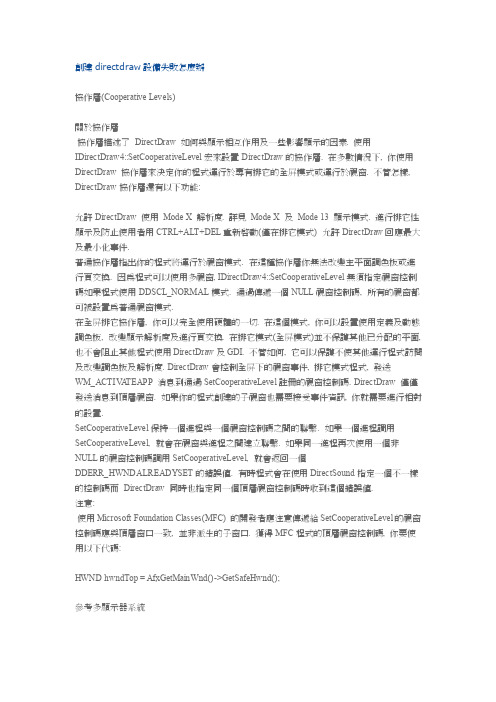
創建directdraw設備失敗怎麼辦協作層(Cooperative Levels)關於協作層協作層描述了DirectDraw 如何與顯示相互作用及一些影響顯示的因素. 使用IDirectDraw4::SetCooperativeLevel宏來設置DirectDraw的協作層. 在多數情況下, 你使用DirectDraw 協作層來決定你的程式運行於專有排它的全屏模式或運行於視窗. 不管怎樣, DirectDraw協作層還有以下功能:允許DirectDraw 使用Mode X 解析度. 詳見Mode X 及Mode 13 顯示模式. 進行排它性顯示及防止使用者用CTRL+ALT+DEL重新啟動(僅在排它模式) 允許DirectDraw回應最大及最小化事件.普通協作層指出你的程式將運行於視窗模式. 在這種協作層你無法改變主平面調色板或進行頁交換. 因為程式可以使用多視窗, IDirectDraw4::SetCooperativeLevel無須指定視窗控制碼如果程式使用DDSCL_NORMAL模式. 通過傳遞一個NULL視窗控制碼, 所有的視窗都可被設置為普通視窗模式.在全屏排它協作層, 你可以完全使用硬體的一切. 在這個模式, 你可以設置使用定義及動態調色板, 改變顯示解析度及進行頁交換. 在排它模式(全屏模式)並不保護其他已分配的平面, 也不會阻止其他程式使用DirectDraw及GDI. 不管如何, 它可以保護不使其他運行程式訪問及改變調色板及解析度. DirectDraw會控制全屏下的視窗事件, 排它模式程式, 發送WM_ACTIV A TEAPP 消息到通過SetCooperativeLevel註冊的視窗控制碼. DirectDraw 僅僅發送消息到頂層視窗. 如果你的程式創建的子視窗也需要接受事件資訊, 你就需要進行相對的設置.SetCooperativeLevel保持一個進程與一個視窗控制碼之間的聯繫. 如果一個進程調用SetCooperativeLevel, 就會在視窗與進程之間建立聯繫. 如果同一進程再次使用一個非NULL的視窗控制碼調用SetCooperativeLevel, 就會返回一個DDERR_HWNDALREADYSET的錯誤值. 有時程式會在使用DirectSound指定一個不一樣的控制碼而DirectDraw 同時也指定同一個頂層視窗控制碼時收到這個錯誤值.注意:使用Microsoft Foundation Classes(MFC) 的開發者應注意傳遞給SetCooperativeLevel的視窗控制碼應與頂層窗口一致, 並非派生的子窗口. 獲得MFC程式的頂層視窗控制碼, 你要使用以下代碼:HWND hwndTop = AfxGetMainWnd()->GetSafeHwnd();參考多顯示器系統測詴協作層開發者通常使用WM_ACTIV A TEAPP 和WM_DISPLAYCHANGE 來通知程式來恢復或重新創建一個已使用的平面. 有時, 程式會收到一些不需要的消息, 或需要時無法獲取消息. IDirectDraw4::TestCooperativeLevel巨集能使你的程式收到更多的DirectDraw物件或適當越過一些錯誤.TestCooperativeLevel巨集調用成功後, 如果你的程式能夠恢復這個平面(如果它還未完成)及繼續執行, 返回DD_OK. 在另一方面, 錯誤碼, 隨不同的協作層而不同:全屏程式:程式會收到DDERR_NOEXCLUSIVEMODE 返回值如果它們失去專有設備訪問(也可稱之為焦點) 例如: 使用者按ALT+TAB切換離開當前程式. 這樣的話, 程式可以在迴圈中調用TestCooperativeLevel, 僅在收到DD_OK後退出迴圈(意味著專有模式恢復了). 在迴圈中, 程式可以放棄對CPU的控制來釋放無用的執行週期. 可以使用Windows 支援的函數如WaitMessage或Sleep的WIN32函數來完成該功能.任何已創建的平面可以用IDirectDrawSurface4::Restore 或IDirectDraw4::RestoreAllSurface 巨集來恢復, 或在顯示前再裝入內容.視窗程式:視窗程式(就是使用普通協作層)會受到DDERR_EXCLUSIVEMODEALREADYSET 錯誤返回值如果另一個程式獲得專有設備訪問權. 這樣的話, 程式不會收到任何消息直到獲得專有設備訪問權的程式失去它. 這種情形和全屏程式相似: 一個視窗程式可以迴圈直到TestCooperativeLevel在恢復平面或再裝入內容之前返回DD_OK. 就象前面一樣, 程式可以在迴圈中放棄對CPU的控制來減少不必要的CPU執行週期. TestCooperativeLevel巨集會在改變顯示模式後在視窗程式中返回DDERR_WRONGMODE值. 這樣的話, 程式應該在繼續運行前銷毀並重新創建平面.。
Indra DOVR双机边带组件互换的影响分析及改善措施

Special Technology专题技术DCW73数字通信世界2021.030 引言生产实践过程中,当DVOR 设备出现单机故障的时候,判断设备故障点最快捷的方式就是:根据故障告警指示,交换双机中可疑的组件,如故障随之转移,那么就可确定故障点。
但以上方法的使用,需要确保DVOR 双机各组件的运行参数基本相同,即每一级组件输出至下一级的信号功率或控制电压需要基本相同。
如双机各组件的运行参数不同,那么组件的互换将不能取得预期的结果,甚至产生一些隐藏的不良后果。
另外,如设备放大组件故障后使用备件进行更换,如备件的运行参数与原组件不相同,那么最终输出也会发射较大的偏离,甚至还会出告警的情况。
下文以DVOR 边带通道中互换SGN 为例,结合SMA 对互换的要求和影响进行分析。
1 边带信号流向及控制DVOR 系统边带信号的产生主要由SGN 、SMAU 、SMAL 三个组件构成。
其中,SGN 产生上、下边带源,SMAU 和SMAL 分别对上、下边带进行放大和调制,最后传输至天馈系统发射。
边带功率最终输出的大小由SGN 和SMA 两个模块共同决定。
标准情况下,SGN 中的边带振荡器输出上下边带信号均为250 mW ,经SMA 进一步放大和调制后,最终输出会在4~6W 之间(功率值根据台站具体情况会有所不同)。
图1 边带信号流向与控制根据图1可知,SGN 的四个输出分为两组传输至SMAU 和SMAL 。
分别是:上边带f+9969 Hz 和CONT VOLT USB (上边带控制电压)、下边带f-9969 Hz 和CONT VOLT LSB (下边带控制电压)。
边带控制电压用于控制后级SMA 的放大性能。
2 交换双机SGN 前后的对比分析我们知道DVOR 的辐射场是由载波和边带在空间叠加而成的,载波与边带需要满足如下条件才能提供稳定、准确的方位信息:(1)频率关系:载波频率为f ,上下边带频率为f ±9960 Hz 。
3D打印机常见问题解析
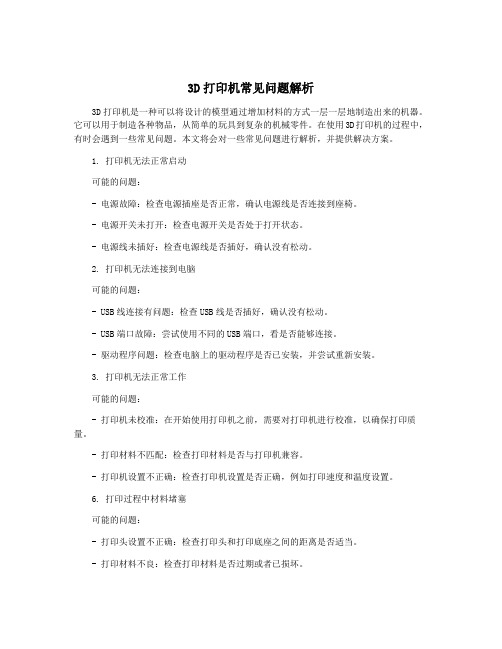
3D打印机常见问题解析3D打印机是一种可以将设计的模型通过增加材料的方式一层一层地制造出来的机器。
它可以用于制造各种物品,从简单的玩具到复杂的机械零件。
在使用3D打印机的过程中,有时会遇到一些常见问题。
本文将会对一些常见问题进行解析,并提供解决方案。
1. 打印机无法正常启动可能的问题:- 电源故障:检查电源插座是否正常,确认电源线是否连接到座椅。
- 电源开关未打开:检查电源开关是否处于打开状态。
- 电源线未插好:检查电源线是否插好,确认没有松动。
2. 打印机无法连接到电脑可能的问题:- USB线连接有问题:检查USB线是否插好,确认没有松动。
- USB端口故障:尝试使用不同的USB端口,看是否能够连接。
- 驱动程序问题:检查电脑上的驱动程序是否已安装,并尝试重新安装。
3. 打印机无法正常工作可能的问题:- 打印机未校准:在开始使用打印机之前,需要对打印机进行校准,以确保打印质量。
- 打印材料不匹配:检查打印材料是否与打印机兼容。
- 打印机设置不正确:检查打印机设置是否正确,例如打印速度和温度设置。
6. 打印过程中材料堵塞可能的问题:- 打印头设置不正确:检查打印头和打印底座之间的距离是否适当。
- 打印材料不良:检查打印材料是否过期或者已损坏。
- 打印材料温度不正确:调整打印材料的温度,使其达到适宜的打印状态。
无论遇到什么问题,重要的是保持耐心和冷静。
通过检查和调整,大部分问题都可以解决。
如果遇到无法解决的问题,可以咨询专业维修人员或联系打印机制造商的客户支持部门。
DirectX问题集合

Q5:怎么看系统的DirectX版本?
A5:开始-运行-输入dxdiag,确认。在弹出的对话框中可以看到系统的DirectX版本(非硬件)
Q6:什么是集成显卡,什么是独立显卡?
A6:集成显卡往往是固化在主板上的,笔记本上较为常见。集成显卡一般性能差,无法胜任大型3D游戏。以Intel生产的显卡为主。独立显卡则是独立与主板存在的,而非板载。因此性能往往高于集成显卡(很好理解,因为它够大- -。当然这种说法是非常不严谨的,一些新的集显完全可以打败过去那些独显,这是毫无争议的。比较显卡性能还是要看测评和参数,只是独显的性能通常都高于集显),适合进行大型游戏。
三、玩老游戏时花屏
这种问题往往出现在高配置或者新配置的电脑上,这种问题往往是由于操作系统兼容性以及硬件导致的。以笔者为例,曾经就遇到红色警戒花屏的问题,但是在配置近乎一样的其他电脑上红色警戒照常运行,唯一不同就是人家是Ati的卡,我的是Nvidia的卡;同样的,在A卡的电脑上不能运行的一些老游戏,我的n卡可以进行的很流畅。这种情况一般就是硬件兼容性或者显卡驱动的兼容性导致的,遇到这样的问题也只能去相关论坛发帖询问,因为不同游戏可能会有不同解决方案。升级显卡驱动也许会有些效果。
Q3:WinXp能不能用DX10、DX11?
A3:不能,微软早就说过了,要想玩DX10、DX11的游戏请用Vista或者Win7甚至将来的Win8。微软也会在不久以后放弃WinXP的更新,所以,想玩基于DX10和DX11的游戏,请换操作系统。
Q4:怎么看显卡支持的DirectX版本?
A4:最专业的软件是GPU-Z,网上可以下载到,不过专业参数很多,需要了解的话要去查找相关资料。其次Everest也是一个可用的硬件检测软件。两种软件都可以识别出显卡以及支持的DirectX版本。最简单的方法,右键我的电脑-设备管理器,展开显示卡项,可以找到显卡名称,但是前提要求你有安装驱动。同时这种方法不能知道显卡DirectX版本,只能知道显卡型号。
3D打印机常见问题解析

3D打印机常见问题解析
3D打印技术因其快速高效的特点,在许多领域得到了广泛的应用。
使用3D打印机时也会遇到一些常见问题。
本文将针对这些问题进行解析,帮助用户更好地理解和解决问题。
1. 打印速度慢
打印速度慢是3D打印过程中常见的问题。
造成这种问题的原因有很多,如打印机设置不当、打印材料不适合、模型设计不合理等。
解决这个问题的方法包括调整打印设置、使用适合的打印材料、优化模型设计等。
2. 打印质量差
3. 打印失败
打印失败是指打印过程中出现错误导致无法完成打印。
造成这种问题的原因有很多,如打印机工作温度过高或过低、打印机内部零件损坏等。
解决这个问题的方法包括调整打印机温度、更换损坏的零件等。
4. 打印模型变形
5. 打印材料粘连
6. 打印机噪音大
7. 打印机死机
8. 打印机无法连接
打印机无法连接是指打印机无法与电脑或其他设备进行正常通信。
造成这种问题的原因有很多,如打印机驱动程序问题、网络设置问题等。
解决这个问题的方法包括重新安装打印机驱动程序、检查网络设置等。
3D打印机常见问题包括打印速度慢、打印质量差、打印失败、打印模型变形、打印材料粘连、打印机噪音大、打印机死机、打印机无法连接等。
解决这些问题的方法要根据具体情况采取相应的措施,如调整打印设置、更换打印材料、修复模型文件、更换损坏的零件等。
通过科学有效的解决方法,用户可以更好地应对3D打印过程中的各种问题,提高打印效果和工作效率。
解决3D打印技术常见问题的实用方法与经验总结

解决3D打印技术常见问题的实用方法与经验总结3D打印技术的快速发展为不同行业带来了巨大的创新和发展潜力。
然而,与任何新技术一样,3D打印技术也存在一些常见问题和挑战。
本文将总结一些解决3D打印技术的常见问题的实用方法和经验,帮助读者更好地利用这一技术。
首先,我们来讨论3D打印中的常见质量问题。
这些问题可能包括打印层间分离、表面缺陷、打印物体结构不稳定等。
为了解决这些问题,我们可以考虑以下方法。
首先,确保打印机的底板平整。
一个不平整的底板会导致打印层间粘连不牢,从而导致打印物体分离。
使用A4纸测试底板的平整度,如果A4纸卡在任何地方,则表明底板需要进行调整。
其次,选择合适的打印速度和温度。
打印速度过快或温度过高可能会导致打印物体表面出现缺陷。
根据打印材料的要求,调整打印机的速度和温度可以帮助改善打印质量。
此外,合理设置支撑结构也是解决3D打印质量问题的关键。
通过为打印物体添加支撑结构,可以减少打印过程中的变形,并提高打印物体的稳定性。
在设计支撑结构时,考虑打印物体的形状和尺寸,并选择合适的支撑结构设计软件。
除了质量问题,3D打印技术还可能面临一些操作和后处理上的挑战。
下面将介绍一些解决这些问题的实用方法。
首先,选择合适的3D打印机和打印材料。
不同的3D打印机适用于不同的打印需求,而不同的打印材料也具有各自的特点和适用范围。
在选择3D打印机和打印材料时,要考虑打印的目的、材料的耐用性和成本等因素。
其次,熟悉和理解打印机的设置和操作。
3D打印机通常配备有各种设置选项,例如打印速度、温度和打印层厚度等。
熟悉这些设置选项,并根据实际需求进行调整,可以提高打印效果。
此外,注意打印物体的定位和支撑。
不正确的打印物体定位可能会导致打印过程中的变形,影响打印质量。
考虑打印物体的形状和尺寸,选择合适的打印方向和添加足够的支撑结构,可以帮助解决这个问题。
在完成3D打印后,通常需要进行后处理来进一步提高打印物体的质量和外观。
Direct3D11教程1Direct3D11基础

交换链即表示对缓冲的操作,这些缓冲就是设备绘制的和显示在屏幕上的内容。交换链包含两个或两个以上的缓冲,主要是前缓冲和后备缓冲,它们就是设备绘制形成的纹理,用于显示在屏幕上。前缓冲(front buffer)就是当前显示在屏幕上的内容,这个缓冲是只读的,无法修改。后备缓冲(back buffer)是设备将要绘制的渲染目标,一旦它完成了绘制操作,交换链就会通过交换前缓冲和后备缓冲,将后备缓冲的内容显示在屏幕上,此时后备缓冲就变成了前缓冲。
D3D_FEATURE_LEVELg_featureLevel =D3D_FEATURE_LEVEL_11_0;
ID3D11Device* g_pd3dDevice =NULL;
ID3D11DeviceContext* g_pImmediateContext =NULL;
IDXGISwapChain* g_pSwapChain =NULL;
要创建交换链,我们需要设置一个DXGI_SWAPCHAIN_DESC结构体说明将要创建的交换链。此结构体的几个字段需要说明一下:BackBufferUsage标志告诉程序我们使用后备缓冲的方式。本例中我们想绘制到后备缓冲,所以将BackBufferUsage设置为DXGI_USAGE_RENDER_TARGET_OUTPUT。OutputWindow字段表示交换链将使用的窗口,在这个窗口上我们显示图像。SampleDesc用来开启多重采样(multi-sampling),因为这个教程不使用多重采样,SampleDesc的Count设置为1,Quality设置为0,这样就禁用了多重采样。
directdraw setmode error

directdraw setmode errorDirectDrawSetMode误是一个比较常见的系统错误,这个错误会导致程序无法正常运行,或者导致程序出现部分错误。
这个错误的发生是由于系统资源不足,以及硬件设备问题引起的。
DirectDraw微软公司提供的图形API,它主要用于图形设备的管理和控制,可以实现2D图形,以及3D图形的绘制和渲染,并可以控制图形设备的显示模式。
SetMode是用来控制显示模式的函数,它可以改变显示模式,从而改变显示的分辨率。
DirectDraw SetMode误的具体表现为:显示的屏幕出现异常,或者程序崩溃。
这个错误可能是由于系统资源不足,系统无法为改变显示模式提供足够的资源,从而导致程序无法正常运行。
另一种可能是由于硬件设备出现问题,导致无法更改显示模式或者分辨率无法改变,从而导致出现错误。
要解决 DirectDraw SetMode误,用户可以采取一下步骤:首先,应该检查系统资源,看看程序能否申请到足够的资源来改变显示模式。
如果系统资源不足,那么可以释放一些资源,或者增加硬件资源来解决问题。
其次,如果系统资源充足,可以检查显卡驱动程序是否是最新的,或者检查显卡是否支持更改显示模式,另外,如果是因为硬件设备故障造成的 DirectDraw SetMode误,那么可以更换硬件设备来缓解问题。
最后,如果以上的步骤都没有解决问题,那么可以通过重装系统的方式来清除 DirectDraw SetMode误。
总之,DirectDraw SetMode误是一个比较常见的系统错误,它可能是由于硬件设备问题引起的,也可能是因为系统资源不足造成的。
要解决这个问题,用户可以检查系统资源,更新显卡驱动,更换硬件设备,甚至重装系统以解决问题。
3D打印技术中常见问题解决方案
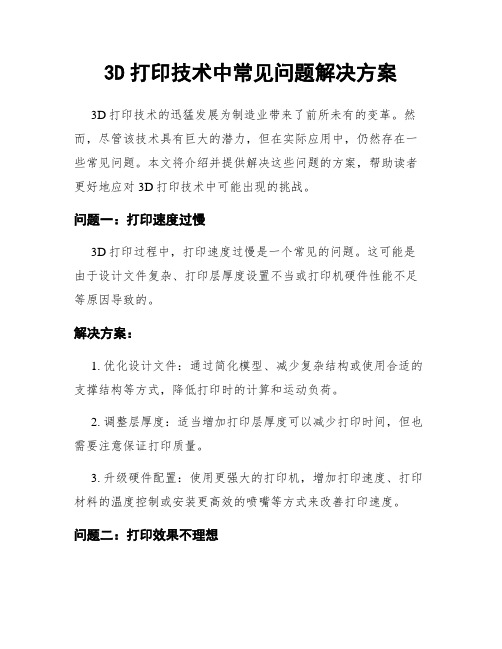
3D打印技术中常见问题解决方案3D打印技术的迅猛发展为制造业带来了前所未有的变革。
然而,尽管该技术具有巨大的潜力,但在实际应用中,仍然存在一些常见问题。
本文将介绍并提供解决这些问题的方案,帮助读者更好地应对3D打印技术中可能出现的挑战。
问题一:打印速度过慢3D打印过程中,打印速度过慢是一个常见的问题。
这可能是由于设计文件复杂、打印层厚度设置不当或打印机硬件性能不足等原因导致的。
解决方案:1. 优化设计文件:通过简化模型、减少复杂结构或使用合适的支撑结构等方式,降低打印时的计算和运动负荷。
2. 调整层厚度:适当增加打印层厚度可以减少打印时间,但也需要注意保证打印质量。
3. 升级硬件配置:使用更强大的打印机,增加打印速度、打印材料的温度控制或安装更高效的喷嘴等方式来改善打印速度。
问题二:打印效果不理想有时,3D打印出来的模型可能出现细节模糊、不平整甚至有空洞等问题。
这通常是由于打印材料选择不当、打印参数设置错误或模型设计错误引起的。
解决方案:1. 选择适当的打印材料:不同的打印材料具有不同的特性和适用范围,选择合适的材料可以提升打印效果。
2. 优化打印参数:根据打印材料的要求和模型设计的特点,调整打印速度、打印温度、喷嘴直径等参数,使其与打印材料相匹配。
3. 检查模型设计:确保模型设计完整且没有错误,使用3D建模软件对模型进行检查和修复,以确保3D打印的模型质量。
问题三:支撑结构难以清除3D打印过程中,模型上的支撑结构是为了保证复杂结构的稳定性而添加的。
然而,这些支撑结构的去除可能会成为一项困难的工作。
解决方案:1. 优化支撑结构设计:使用3D建模软件或打印机软件,优化支撑结构的设计,减少支撑结构对模型表面的影响。
2. 合理调整打印参数:合理调整打印参数,如支撑结构的密度、材料和打印温度等,以便在打印完成后能够更容易地将支撑结构移除。
3. 使用工具协助清除:使用剪刀、镊子或刮刀等工具来辅助支撑结构的清除,需要仔细操作以避免损坏模型。
Direct3D应用中的2D应用

Direct3D应用中的2D应用2D Application 收藏(转载)2D Application这一章将讨论IDirect3DDevices9接口怎样应用到简单的两维应用程序里去。
然而,接下来讨论的方法和接口的方法不仅仅只应用在两维应用程序里面。
开始我们将看看IDirect3DSurface9接口,它用于存放像素数据。
我们将看看怎样创建surfaces,怎样填充数据,并且执行像素拷贝操作。
接下来,我们讨论IDirect3DSwapChain9接口管理back buffer集合。
设备创建的时候都会携带一个默认的swap chain,但是也可以为window模式下多个视图创建新的swap chain。
再接下来,我们将讨论Presentation,Present 也是IDirect3DDevice9提供的方法。
即使Direct3D可以不使用GDI,但是他们也要处理发送到应用程序top-level窗口的消息。
我们推荐使用Direct3D应用程序来处理窗口消息。
DirectX 并没有提供直接方法来将GDI和Direct3D结合起来。
但是,通常是在内存DC和流水线产生的结果像素数据上执行GDI操作。
页脚内容1最后,我们将讨论流水线的Video scan out部分以及swap chain从back buffer到front back 的过程。
video scan out 电流读取数据,使用cursor overlay,gamma校正以及像素数据转化成monitor的模拟信号。
Pixel SurfacePixel 面是像素数据的矩形集合。
像素数据的内存layout是通过D3DFORMAT定义的。
在设备上使用surface有几处地方:back buffer surfaces, depth/stencil buffer surfaces,纹理层surface,render target surface 以及图片surface。
关于Direct3D11里汉字显示的一些思考

关于Direct3D11里汉字显示的一些思考这篇文章里,浅墨希望与大家一起探讨一下Direct3D11中关于字体显示的一些问题。
一、关于Direct2D与DirectWrite先讲讲Direct2D和DirectWrite吧,下面关于字体讨论的时候有涉及到的地方。
首先,Direct2D,它是DirectX11附带着发布的全新的二维图形API。
顾名思义,看到Direct2D立马想到了它的大哥Direct3D。
的确,Direct2D就是仿照着Direct3D来设计的,一款支持硬件加速的即时模式的二维图形API,因为支持硬件加速,Direct2D跑起来比GDI,GDI+效率都高。
Direct2D用于取代DirectDraw,可用于2D游戏开发,但是目前世界范围内对Direct2D 研究热情似乎不高。
关于DirectWrite,它也是DirectX11中的新组件,主要是配合Direct2D 使用,用于Direct2D应用程序中的字体和文字渲染。
二、Direct3D11里文字显示的一些讨论然后我们就开始正题,Direct3D11中关于文字显示方案的一些讨论,特别是汉字的显示问题。
Direct3D11中微软非常奇葩地移除了ID3DXFont这个在Direct3D 9中非常好用的字体接口,这样导致了目前的Direct3D11中竟然没有一个官方的字体解决方案- -,这真心不科学。
要在Direct3D11中显示文字,除去那已经在DirectX11中离我们远去的D3DXFont接口,我们还可以想到的字体解决方案主要就以下三种(且不管方法正不正确,我们先把他们列举出来):第一种方案,用子图形贴图的方式。
第二种方案,与GDI/GDI+进行交互,使用GDI/GDI+中虽然相对Direct3D来说低效,却五脏俱全的2D字体体系。
第三种方案,使用DirectX11中专门设计用来加强Windows中2D文字显示质量的全新API——DirectWrite。
Direct3D11Tutorial1:Basics_Direct3D11教程1:基础
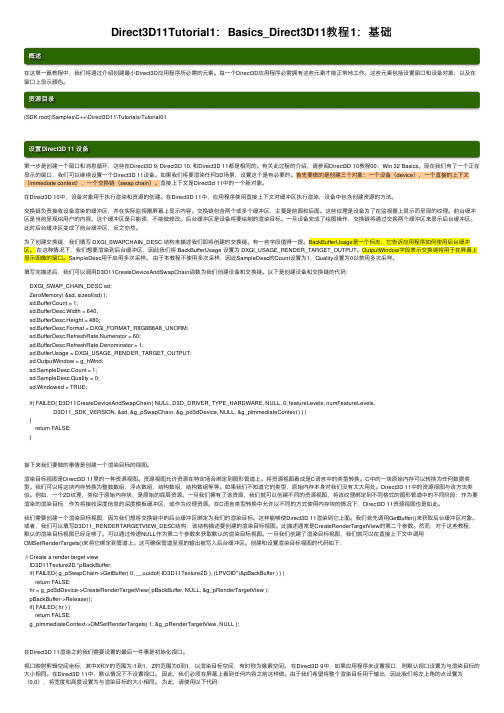
Direct3D11Tutorial1:Basics_Direct3D11教程1:基础概述在这第⼀篇教程中,我们将通过介绍创建最⼩Direct3D应⽤程序所必需的元素。
每⼀个Direct3D应⽤程序必需拥有这些元素才能正常地⼯作。
这些元素包括设置窗⼝和设备对象,以及在窗⼝上显⽰颜⾊。
资源⽬录(SDK root)\Samples\C++\Direct3D11\Tutorials\Tutorial01设置Direct3D 11 设备第⼀步是创建⼀个窗⼝和消息循环,这些在Direct3D 9, Direct3D 10, 和Direct3D 11都是相同的。
有关此过程的介绍,请参阅Direct3D 10教程00:Win 32 Basics。
现在我们有了⼀个正在显⽰的窗⼝,我们可以继续设置⼀个Direct3D 11设备。
如果我们将要渲染任何3D场景,设置这个是有必要的。
⾸先要做的是创建三个对象:⼀个设备(device),⼀个直接的上下⽂(immediate context),⼀个交换链(swap chain)。
直接上下⽂是Direct3d 11中的⼀个新对象。
在Direct3D 10中,设备对象⽤于执⾏渲染和资源的创建。
在Direct3D 11中,应⽤程序使⽤直接上下⽂对缓冲区执⾏渲染,设备中包含创建资源的⽅法。
交换链负责接收设备渲染的缓冲区,并在实际监视器屏幕上显⽰内容。
交换链包含两个或多个缓冲区,主要是前⾯和后⾯。
这些纹理是设备为了在监视器上显⽰⽽呈现的纹理。
前台缓冲区是当前呈现给⽤户的内容。
这个缓冲区是只能读,不能做修改。
后台缓冲区是设备将要绘制的渲染⽬标。
⼀旦设备完成了绘图操作,交换链将通过交换两个缓冲区来显⽰后台缓冲区。
此时后台缓冲区变成了前台缓冲区,反之亦然。
为了创建交换链,我们填写 DXGI_SWAPCHAIN_DESC 结构来描述我们即将创建的交换链。
有⼀些字段值得⼀提。
BackBufferUsage是⼀个标志,它告诉应⽤程序如何使⽤后台缓冲区。
Direct3D11教程1Direct3D11基础

Direct3D11教程1Direct3D11基础Direct3D 11 教程1:Direct3D 11基础原文地址:。
概览在第一个教程中,我们学习了创建一个最小Direct3D 11应用程序所需的元素,每个Direct3D 11应用程序必须包含这些元素才能正常工作,这些元素包括创建一个窗口和设备对象,然后才能在窗口中显示颜色。
源代码(SDK root)\Samples\C++\Direct3D11\Tutorials\Tutorial01。
创建Direct3D 11设备第一个步骤中的创建窗口和消息循环在Direct3D 9、Direct3D 10、Direct3D 11都是相同的,可参见Direct3D 10教程0:Win32编程基础理解这个过程。
当显示了一个窗口后,下面继续创建一个Direct3D 11设备,这个设备用于绘制3D场景。
首先必须创建三个对象:一个设备(device)、一个立即执行上下文(immediate context)和一个交换链(Swap Chain),立即执行上下文对象是Direct3D 11中新添加的。
在Direct3D 10中,设备同时用来绘制和资源的创建。
在Direct3D 11中,立即执行上下文用于将内容绘制到缓存,而设备用于创建资源。
交换链即表示对缓冲的操作,这些缓冲就是设备绘制的和显示在屏幕上的内容。
交换链包含两个或两个以上的缓冲,主要是前缓冲和后备缓冲,它们就是设备绘制形成的纹理,用于显示在屏幕上。
前缓冲(front buffer)就是当前显示在屏幕上的内容,这个缓冲是只读的,无法修改。
后备缓冲(back buffer)是设备将要绘制的渲染目标,一旦它完成了绘制操作,交换链就会通过交换前缓冲和后备缓冲,将后备缓冲的内容显示在屏幕上,此时后备缓冲就变成了前缓冲。
要创建交换链,我们需要设置一个DXGI_SWAPCHAIN_DESC结构体说明将要创建的交换链。
此结构体的几个字段需要说明一下:BackBufferUsage标志告诉程序我们使用后备缓冲的方式。
Direct2D教程

Direct2D教程(一)Direct2D已经来了,谁是GDI的终结者?什么是Direct2D一言以蔽之,就是Windows 7平台上的一个2D图形API,可以提供高性能,高质量的2D渲染。
大多数人对Direct2D 可能都比较陌生,以至于我之前在论坛上提到这个词的时候,有人竟然说你是不是写错了?可能大家比较熟悉的是Direct3D,因为D3D已经是当前游戏界的主流应用。
在过去,3D世界是OpenGL与DirectX二分天下,但是由于OpenGL发展十分滞后,而且没有一个像微软这样强大的后台支柱,所以逐渐被DirectX所超越。
回过头来说2D,过去Windows上的2D程序还主要基于GDI和GDI+,遗憾的是这两者都是软件实现,而Direct2D则不同,它基于Direct3D,所以能够使用硬件加速功能,能更大程度的发挥硬件特性,创建高性能,高质量的2D图形,这些图形包括几何图形,如矩形,椭圆等。
还有位图,文本。
而且更方便的是,Direct2D与GDI,GDI+和D3D都是可以交互的。
运行需求要开发和使用Direct2D程序,系统必须是Windows 7,Windows Vista SP2,Windows Server 2008 R2或者Windows Server 2008 SP2,这样的系统需求无疑会稍稍阻碍Direct2D前进的步伐,虽然Vista和Windows 7已经推出有一段时间了,但是不可否认的是,仍然有很多人在使用XP系统。
甚至是Win2K。
但是新技术的普及是不可阻碍的,相信不久的将来,Direct2D将会成为2D图形世界的主流。
D2D的架构Direct2D是基于Direct3D 10.1 API构建的,这意味着Direct2D可以使用硬件加速,下图是Direct2D与Direct3D的一个关系图由上图可以看出,Direct2D还自带了一个软件实现(Software rasterizer),这是因为如果显卡不支持硬件加速,那么Direct2D可以使用软件方式渲染,即使这样,效果还是要优于GDI的。
Direct3D应用中的2D应用

Direct3D应用中的2D应用2D Application 收藏(转载)2D Application这一章将讨论IDirect3DDevices9接口怎样应用到简单的两维应用程序里去。
然而,接下来讨论的方法和接口的方法不仅仅只应用在两维应用程序里面。
开始我们将看看IDirect3DSurface9接口,它用于存放像素数据。
我们将看看怎样创建surfaces,怎样填充数据,并且执行像素拷贝操作。
接下来,我们讨论IDirect3DSwapChain9接口管理back buffer 集合。
设备创建的时候都会携带一个默认的swap chain,但是也可以为window模式下多个视图创建新的swap chain。
再接下来,我们将讨论Presentation,Present 也是IDirect3DDevice9提供的方法。
即使Direct3D可以不使用GDI,但是他们也要处理发送到应用程序top-level窗口的消息。
我们推荐使用Direct3D应用程序来处理窗口消息。
DirectX 并没有提供直接方法来将GDI和Direct3D结合起来。
但是,通常是在内存DC和流水线产生的结果像素数据上执行GDI操作。
最后,我们将讨论流水线的Video scan out部分以及swap chain从back buffer到front back 的过程。
video scan out 电流读取数据,使用cursor overlay,gamma校正以及像素数据转化成monitor的模拟信号。
Pixel SurfacePixel 面是像素数据的矩形集合。
像素数据的内存layout 是通过D3DFORMAT定义的。
在设备上使用surface有几处地方:back buffer surfaces, depth/stencil buffer surfaces,纹理层surface,render target surface 以及图片surface。
- 1、下载文档前请自行甄别文档内容的完整性,平台不提供额外的编辑、内容补充、找答案等附加服务。
- 2、"仅部分预览"的文档,不可在线预览部分如存在完整性等问题,可反馈申请退款(可完整预览的文档不适用该条件!)。
- 3、如文档侵犯您的权益,请联系客服反馈,我们会尽快为您处理(人工客服工作时间:9:00-18:30)。
Direct 2D与Direct 3D 11协同工作时遇到的一些问题Direct 2D与Direct 3D 11协同工作时遇到的一些问题1、前言最近在把游戏引擎的API从DirectX 9升级到DirectX 11,因为两套API之间存在巨大的差异,因此在升级迁移的过程中撞了不少坑,现在主要把Direct 2D和Direct3D 11协同工作时遇到的问题总结一下。
原来的游戏引擎对纹理做处理的时候(如写字、绘制简单图形等)用的都是GDI+这套API,使用的方法也比较傻,就是在内存中存两套完全相同的图片,一套交给Direct 3D作为纹理,一套作为Bitmap保留在GDI+中,当需要对纹理做一些处理的时候,首先在Bitmap中用GDI+来处理,然后把Direct 3D中的纹理Lock住,然后往里面逐个拷贝像素。
在打算升级到DirectX 11的时候,就已经打算不再使用GDI+了,改为使用Direct 2D,毕竟Direct 2D有硬件加速并且更加底层,而且能够直接和Direct 3D交互。
2、思路对于Direct 2D和Direct 3D的交互,我的主要思路是在Direct 2D中绘制图片,然后作为纹理让Direct 3D使用,中途参考了MSDN上的文档:Direct2D and Direct3D Interoperability Overview我一开始是按照这篇文章中Using Direct2D Content as a Texture这一小节的说明为指导来进行编写的,但是在前面的工作都顺利完成的时候,最后卡在了这里:hr = m_pD2DFactory->CreateDxgiSurfaceRenderTarget(pDxgiSurface,&props,&m_pRenderTarget);也就是我无论如何都无法创建一个DxgiSurfaceRenderTarget,hr返回值永远都是INVALIDARGS。
而整体的思路很简单,将Direct2D的操作作为纹理让Direct3D能够使用的步骤如下:1.Direct 3D创建一个离屏纹理OffscreenTexcture作为Direct 2D的渲染对象;2.对OffscreenTexcture创建相应的DxgiSurface作为离屏表面;3.对DxgiSurface创建Direct 2D的RenderTarget。
当我们拿到RenderTarget之后就能够和Direct 2D中的其他普通渲染对象一样,进行各种操作了;但问题就在于,我现在无法创建这个渲染对象。
于是我Google了很久,开始怀疑是我的Direct 3D初始化的问题,接着又怀疑是我的显卡驱动问题;找了半天,我注意到上面那篇文章讲的是Direct X 10和Direct 2D的交互——开始怀疑是Direct X版本的问题,于是按着这个思路搜索,终于在Stack Overflow上找到了这样一个回答:Can Direct2D actually work with a direct3D 11 device?综合另外一些搜索结果我大致得到了以下结论:Direct 2D是基于DirectX 10.1的,不能保证它可以和DirectX10.1以外的API按照上面那篇MSDN的文章的说明来直接交互。
当然,有的地方又说在Windows 8以后Direct 3D 11是可以和Direct 2D交互的,然而我是Windows 10,就我自己的结果来看,是不可以的。
但是我想因为Direct 2D的这个问题把API降级到DirectX 10.1,但另一方面对Direct 2D又不死心——实在是不怎么想继续用GDI+,因此就以Using DirectX 11 With Direct 2D为中心来搜索,终于,搜了大半天让我搜到了下面这篇答案:Can't create Direct2D DXGI Surface下面的回答:Direct2D only works when you create a Direct3D 10.1 device,but it can share surfaces with Direct3D 11. All you need todo is create both devices and render all of your Direct2Dcontent to a texture that you share between them. I use thistechnique in my own applications to use Direct2D withDirect3D 11. It incurs a slight cost, but it is small andconstant per frame.A basic outline of the process you will need to use is: Create your Direct3D 11 device like you do normally.1.Create a texture with theD3D10_RESOURCE_MISC_SHARED_KEYEDMUTEX option inorder to allow access to the ID3D11KeyedMutexinterface.2.3.Use the GetSharedHandle to get a handle to the texturethat can be shared among devices.4.5.Create a Direct3D 10.1 device, ensuring that it iscreated on the same adapter.6.7.Use OpenSharedResource function on the Direct3D 10.1device to get a version of the texture for Direct3D10.1.8.9.Get access to the D3D10 KeyedMutex interface for thetexture.10.11.Use the Direct3D 10.1 version of the texture to createthe RenderTarget using Direct2D.12.13.When you want to render with D2D, use the keyed mutexto lock the texture for the D3D10 device. Then, acquireit in D3D11 and render the texture like you wereprobably already trying to do.14.It's not trivial, but it works well, and it is the way thatthey intended you to interoperate between them. Windows 8looks like it will introduce full D3D11 compatibility, so itwill be just as simple as you expect.这里给了我两个关键字:GetSharedHandle以及Open SharedResource,终于,在MSDN上又找到了下面这篇文章:Surface Sharing Between Windows Graphcis APIs这篇文章介绍了如何在不同的Windows Graphcis API之间共享Surface,这里我只说一下怎么让Direct 2D和Direct 3D进行交互:1.创建Direct 3D 10.1的D3D Device;2.用Direct 3D 11的D3D Device创建纹理SharedTexture,并且把纹理描述符的MiscFlags设置为D3D10_RESOURCE_MISC_SHARED_KEYEDMUTEX;3.通过SharedTexture创建IDXGIResource,转换为作为所有API的共享资源;4.通过IDGIResource获得该资源的共享句柄SharedHandle;5.此外还需要IDGIResource获取属于Direct 3D 11的SyncSurface的Sync Mutex(IDXGIKeyedMutex);上面1-5步是完成将Direct 3D 11的纹理作为IDGIRersource共享的工作,接下来是如何将其重新取出来并且“转化”成Direct 10.1版本的Sync Surface。
1.通过Direct 3D 10.1的D3D Device通过OpenSharedResource将之前用Direct 3D 11存进去的Texture读出来,并且转换为相应的格式的Sumc Surface。
(MSDN上直接转换成了ID3D10Texture2D那是因为示例是两个Direct 3D 10.1之间的共享,但是如果是不同API之间的共享的话,这里应该转换成IDXGISurface1,这是一个巨坑,我在这里调试了好久,程序一直Crash掉);2.此外,还要从读出来的Sync Surface获取转换过后的属于Direct 10.1的Sync Mutex;上面两步间接地完成了“转换”的步骤,而如果要进行实际的操作的话还需要以下两步:1.如果是Direct 3D 11侧需要操作共享表面,那么就必须事先对Direct 3D 11的Sync Mutex进行锁住以保证两套API之间的同步;2.反之;如果是Direct 3D 10.1侧需要操作共享表面,那么就必须事先对Direct 3D 10.1的Sync Mutex进行锁住以保证两套API之间的同步。
3、踩坑如果说按照上面的步骤来做的话,应该就完成了,但是我在做的时候依然问题不断。
第一个问题就是代码死活创建不了Sync Surface,程序一运行到这里就报错了。
float fDpiX = 0.0f;float fDpiY = 0.0f;m_pD2DFactory->GetDesktopDpi(&fDpiX, &fDpiY);auto dsProps = D2D1::RenderTargetProperties(D2D1_RENDER_TARGET_TYPE_HARDWARE,D2D1::PixelFormat(DXGI_FORMAT_R8G8B8A8_UNORM,D2D1_ALPHA_MODE_PREMULTIPLIED),fDpiX,fDpiY);hResult = m_pD2DFactory->CreateDxgiSurfaceRenderTarget(pDxgiSurface,&dsProps,&pDxgiRenderTarget);if (FAILED(hResult)) {goto failed_release;}代码大概是这样的,在m_pD2DFactory->CreateDxgiSurfaceRenderTarget这里,hResult一直是INVALIDARGS,我查了很久的问题都没解决。
